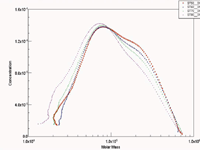Self-Aggregation of Gelatin
Gelatin is the denatured form of collagen, the main component of skin, bone, and connective tissues of animals.
Gelatin is the denatured form of collagen, the main component of skin, bone, and connective tissues of animals. Its special properties are a sharp sol-gel transition, low sol viscosity and high effectiveness as a protective colloid.
For properties of aqueous mixtures of gelatin with other biopolymers, the character of aggregates of a-chains is important: the entropy of mixing is reduced when gelatin chains are limited in their mobility by aggregation.
SEC-MALS was used to study the aggregation behavior of gelatin solutions as a function temperature without using denaturing agents, such as urea or SDS. In addition to the usual concentration detection by refractive index, optical rotation detection was applied to detect any changes in the degree of helicity of the gelatin chains.
After soaking overnight at 4 °C, gelatin was heated for 30 min at 80 °C and subsequently kept for 60 min at the temperature of the measurement (50–80 °C). The eluent was a 0.01 M potassium phosphate buffer of pH 6.7 with 0.125 M LiNO3. The column set consisted of a precolumn PWH, 6000 PW and 3000 PW (all of TSK).

Figure 1: Concentration as a function of molar mass.
Figure 1 and 2 show a reversible change of the bimodal molar mass distribution of two different porcine gelatins at temperatures between 50 °C and 80 °C (number in legend corresponds to temperature), i.e. well above the gelation temperature of about 30 °C.

Figure 2: Another sample's concentration as a function of molar mass.
The effect of temperature on the molar mass distribution suggests the existence of a monomer-dimer equilibrium between gelatin chains (the shoulder corresponding to the monomer was 90–100 kDa and the one corresponding to the dimer was ca. 200 kDa). The results explain the different behavior of these gelatins in mixtures with other biopolymers.
The ratio of the refractive index and the optical rotation was constant for MM <ca. 400 kDa and is independent of temperature. No involvement of helix formation could be detected.
This note graciously submitted by R.H. Tromp and C. Olieman, NIZO Food Research, Kernhemseweg 2, 6718 ZB, Ede, The Netherlands.
DAWN®, miniDAW®, ASTRA®, Optilab®, DynaPro®, Protein Solutions® and the Wyatt Technology logo are registered trademarks of Wyatt Technology Corporation. ©2011 Wyatt Technology Corporation.
Wyatt Technology Corporation
6300 Hollister Avenue, Santa Barbara, CA 93117
tel. (805) 681-9009, fax (805) 681-0123
Website: www.wyatt.com

SEC-MALS of Antibody Therapeutics—A Robust Method for In-Depth Sample Characterization
June 1st 2022Monoclonal antibodies (mAbs) are effective therapeutics for cancers, auto-immune diseases, viral infections, and other diseases. Recent developments in antibody therapeutics aim to add more specific binding regions (bi- and multi-specificity) to increase their effectiveness and/or to downsize the molecule to the specific binding regions (for example, scFv or Fab fragment) to achieve better penetration of the tissue. As the molecule gets more complex, the possible high and low molecular weight (H/LMW) impurities become more complex, too. In order to accurately analyze the various species, more advanced detection than ultraviolet (UV) is required to characterize a mAb sample.















